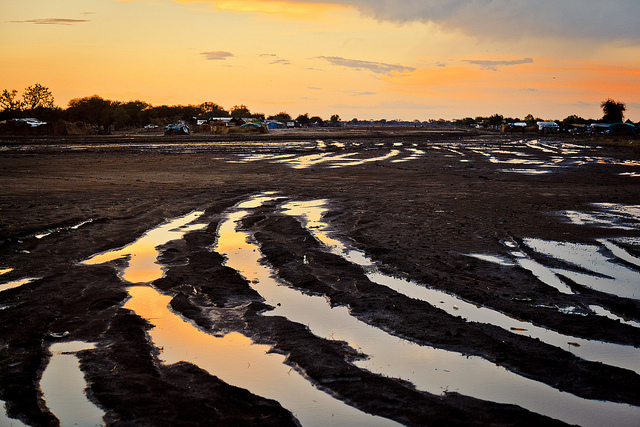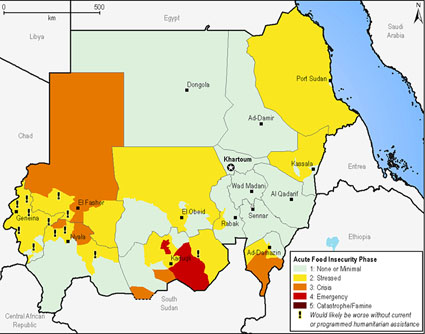
The recent fighting along the border of Sudan and South Sudan has sparked even further food insecurity in the region. According to a report by the Famine Early Warning System Network, or FEWSNET, released this month that covers and projects for the period from April to September, the size of the food insecure population in Sudan has increased to 4.7 million people due to escalated conflict and reduced access to food. Food insecurity is of the greatest concern in areas controlled by the Sudan People’s Liberation Movement-North, or SPLM-N, in the border state of South Kordofan, where approximately 200,000-250,000 people face “Crisis” to “Emergency” levels. The emergency level of food insecurity is one level short of famine on the FEWSNET scale.
This is a foreshadowing of what is to come if the fighting continues. The report cites increased fighting as a major driver of food insecurity in Sudan due to the direct effects of clashes—such as reduced access to farms, damage to harvests, and civilian displacement—as well as the consequential restrictions on trade flow, population movement and humanitarian assistance, with the potential for escalation and expansion into other border areas of Sudan and South Sudan. It also attributes the high levels of food insecurity to factors such as this year’s poor harvest and inflated food prices in most areas.
The report projects that food security outcomes will further deteriorate throughout the outlook period.
In areas controlled by the SPLM-N in Blue Nile state, approximately 100,000-150,000 people face Crisis levels of food insecurity due to circumstances similar to those present in South Kordofan, such as restrictions on trade, movement, and assistance. An additional 100,000 people in Blue Nile face Stressed levels of food insecurity.
Furthermore, approximately 1 million people in other Sudanese states—Red Sea, North Kordofan, White Nile, and Kassala—are susceptible to Stressed levels of food insecurity mainly because of a poor rainy season coupled with reduced purchasing power due to high inflation. Additionally, approximately 100,000-120,000 IDPs from Abyei located in Agok face Crisis levels of food insecurity, while the majority of Darfur’s 1.8 million IDPs face Stressed levels of food insecurity.
The upcoming rainy season will add to the food insecurity, particularly in South Kordofan and Blue Nile, where the rains will make travel difficult and some places inaccessible, exacerbating Khartoum’s ban on humanitarian assistance. The rainy season is, as well, the period during which Sudanese in these two states plant their crops for future harvest. Ongoing conflict will prevent many from planting, which may, in turn, exacerbate food insecurity during the upcoming dry season. The following FEWSNET timeline displays Sudan’s current and upcoming critical seasons, including the planting season, the rainy season, and the “lean” season.
The issue of food insecurity and the upcoming rainy season is also ominous for South Sudan. The U.N. has warned that more than half of South Sudan's population faces food shortages due to continued conflict with Sudan, intercommunal violence, and the government of South Sudan’s decision to shut down oil production.
Earlier this month, Jon Cunliffe, South Sudan country director for Save the Children, described the dire situation in both countries and the urgent need to end the fighting and permit humanitarian access. He said:
A toxic combination of conflict, rising food and fuel prices, and severe cash shortages is having a devastating effect on the civilian population in both countries. With the rains on the way the situation could not be more critical. We urgently need the fighting to stop so that we can get access and children can be protected from violence, deprivation, displacement and recruitment.
In Resolution 2046, the U.N. Security Council “strongly urged” Khartoum and the SPLM-N to accept the Tripartite Proposal of the African Union, the U.N., and the Arab League to permit humanitarian access to civilians in Blue Nile and South Kordofan states. The SPLM-N has accepted the proposal and expressed its willingness to initiate a “humanitarian cessation of hostilities” to allow for its implementation. Khartoum, however, has rejected the proposal and continues to deny international humanitarian access to South Kordofan and Blue Nile.
The Enough Project continues to stress the need for full humanitarian access to all areas within South Kordofan and Blue Nile states, as well as throughout the greater Sudan, and continues to monitor all parties’ compliance to the conditions set forth in Resolution 2046.
Photo: The airstrip in Agok during the 2011 spring rainy season (Enough / Tim Freccia)



